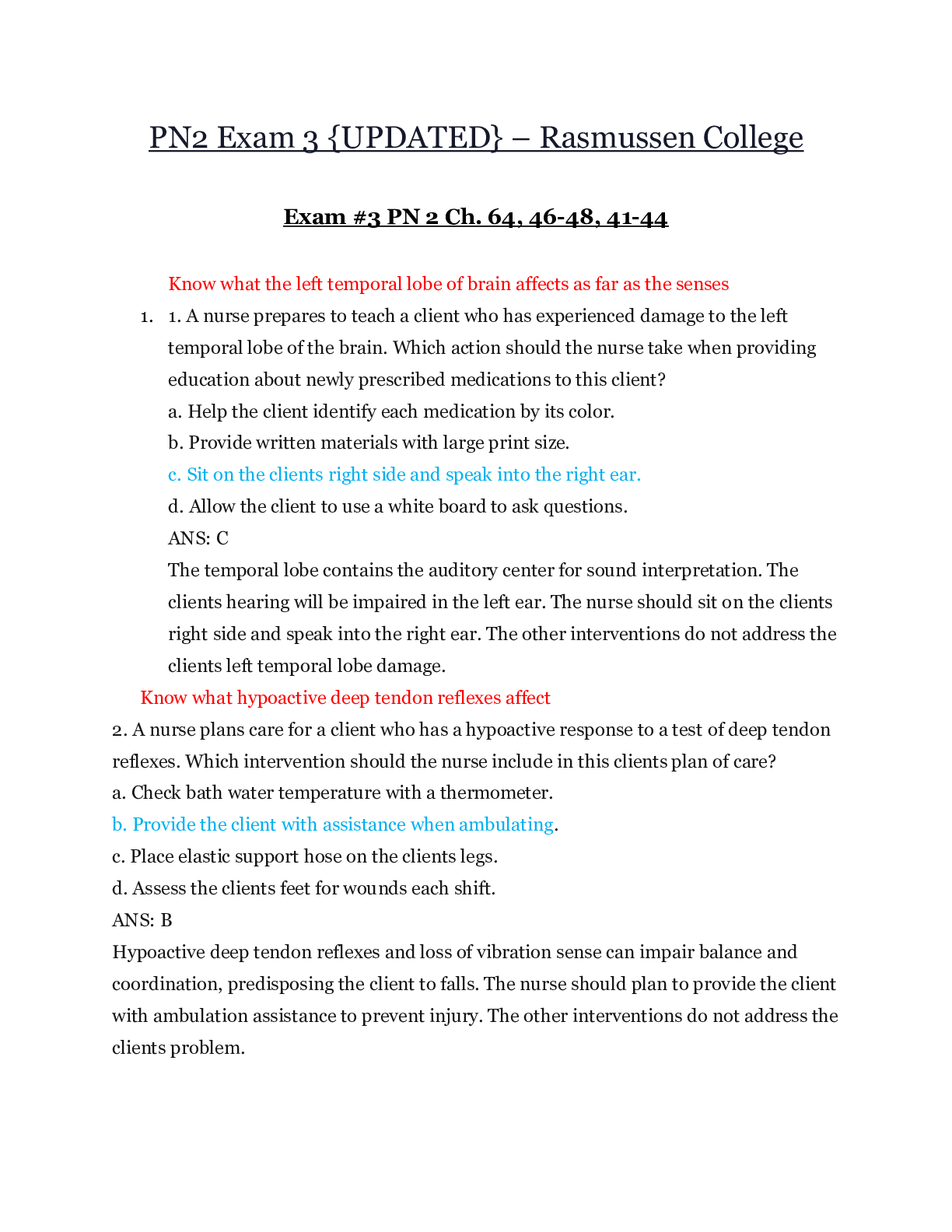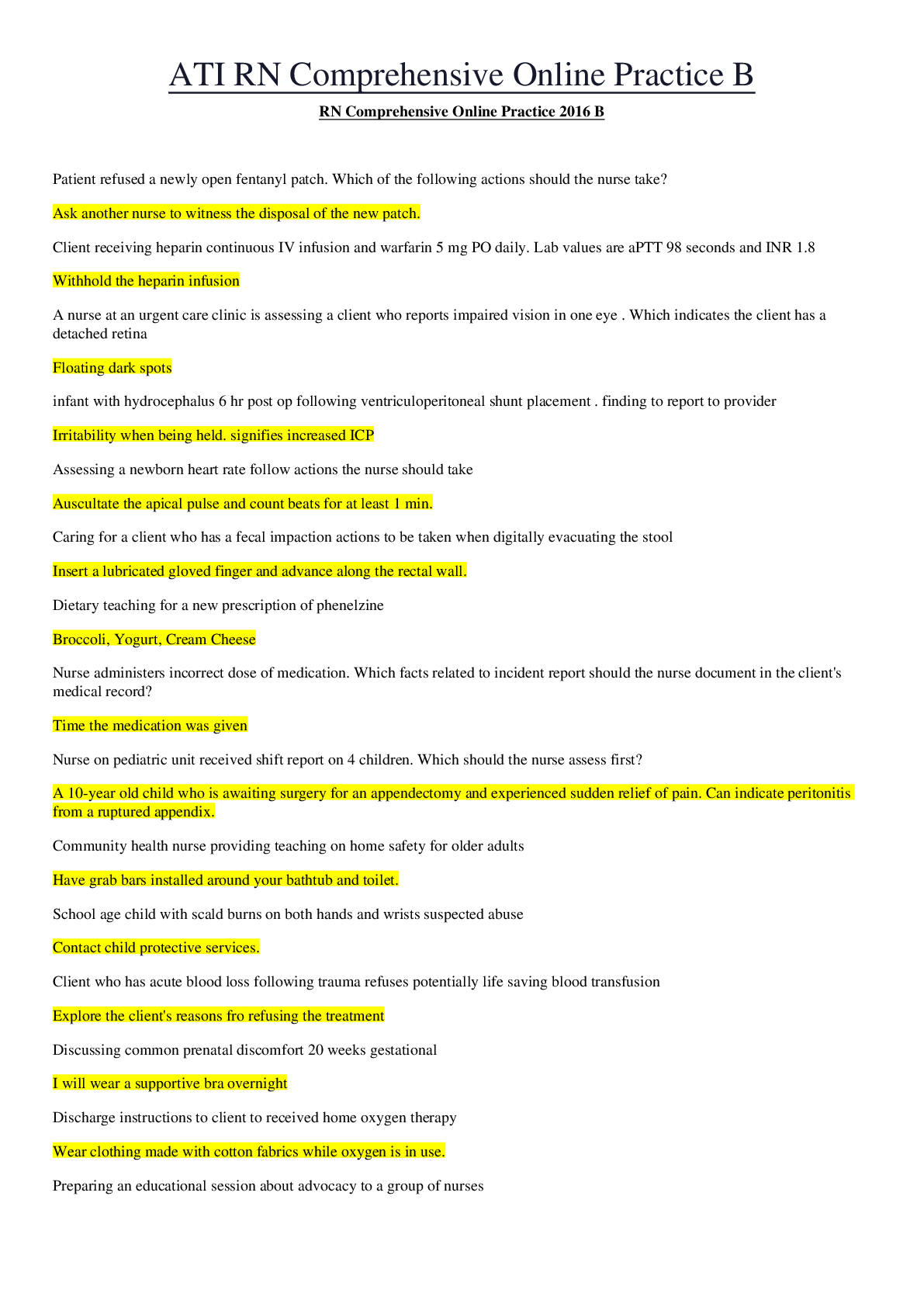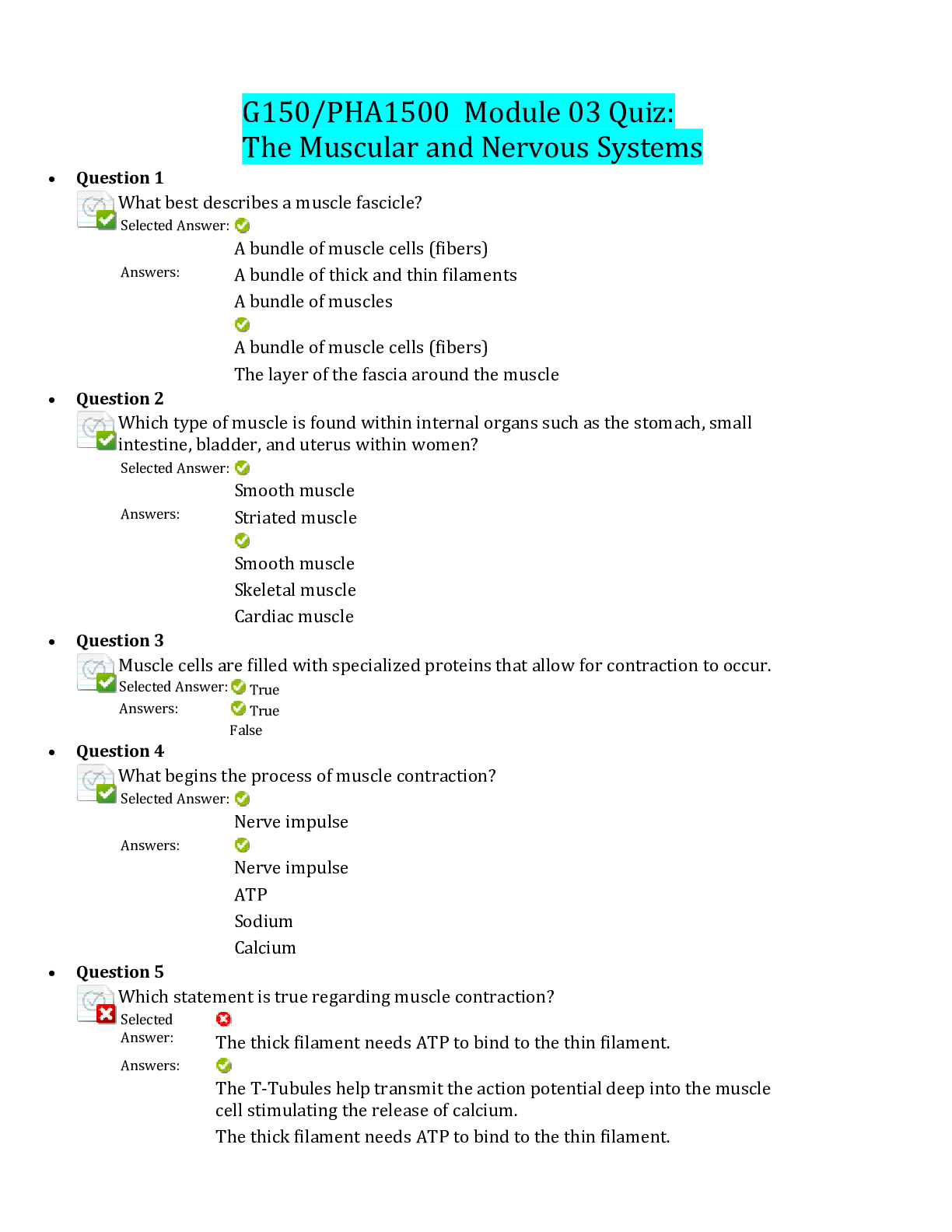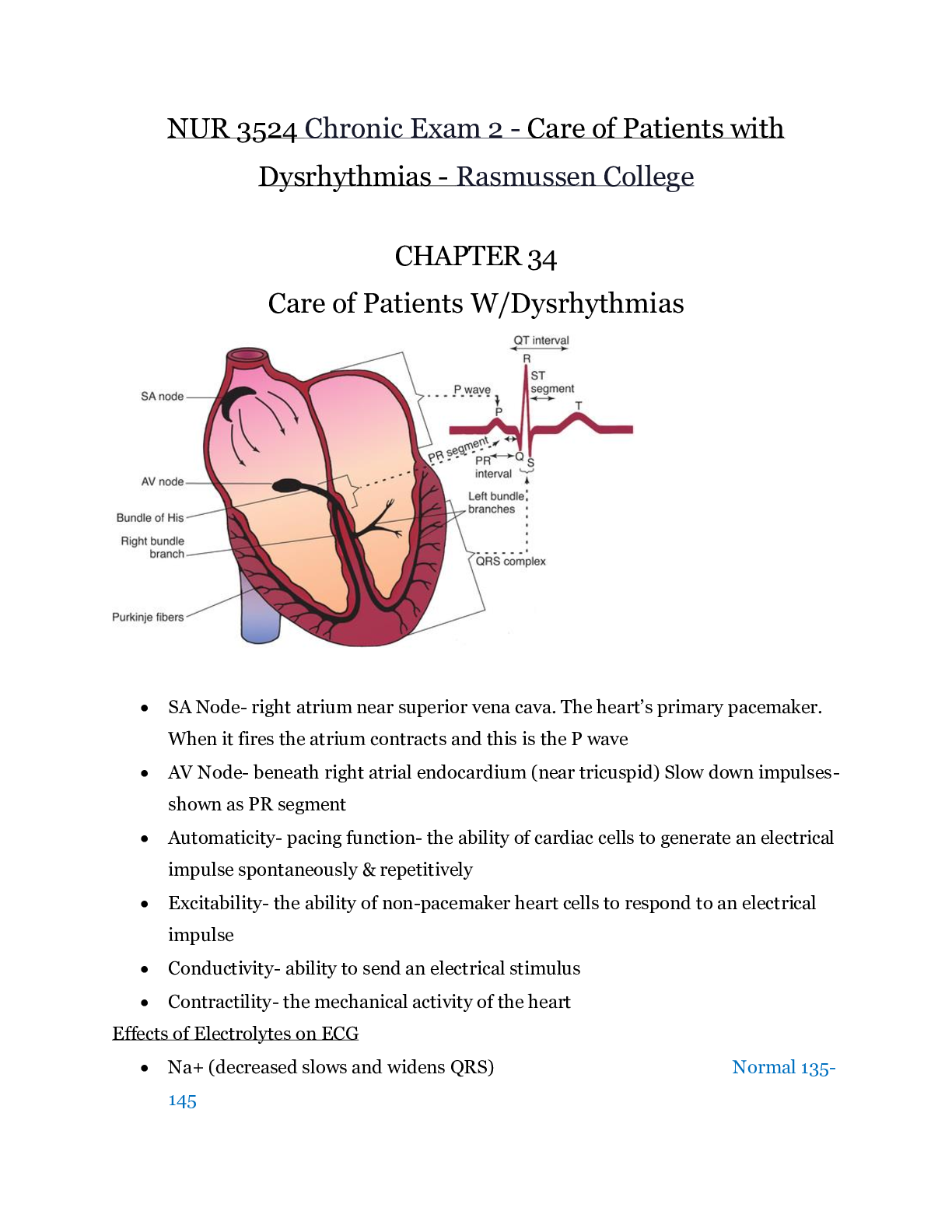PN2 Exam 3 {UPDATED} – Rasmussen College | Professional Nursing II
Document Content and Description Below
PN2 Exam 3 {UPDATED} – Rasmussen College Exam #3 PN 2 Ch. 64, 46-48, 41-44 Know what the left temporal lobe of brain affects as far as the senses 1. 1. A nurse prepares to teach a client who... has experienced damage to the left temporal lobe of the brain. Which action should the nurse take when providing education about newly prescribed medications to this client? a. Help the client identify each medication by its color. b. Provide written materials with large print size. c. Sit on the clients right side and speak into the right ear. d. Allow the client to use a white board to ask questions. ANS: C The temporal lobe contains the auditory center for sound interpretation. The clients hearing will be impaired in the left ear. The nurse should sit on the clients right side and speak into the right ear. The other interventions do not address the clients left temporal lobe damage. Know what hypoactive deep tendon reflexes affect 2. A nurse plans care for a client who has a hypoactive response to a test of deep tendon reflexes. Which intervention should the nurse include in this clients plan of care? a. Check bath water temperature with a thermometer. b. Provide the client with assistance when ambulating. c. Place elastic support hose on the clients legs. d. Assess the clients feet for wounds each shift. ANS: B Hypoactive deep tendon reflexes and loss of vibration sense can impair balance and coordination, predisposing the client to falls. The nurse should plan to provide the client with ambulation assistance to prevent injury. The other interventions do not address the clients problem. Know what things can interfere with MRI scans 10. A nurse obtains a focused health history for a client who is scheduled for magnetic resonance imaging (MRI). Which condition should alert the nurse to contact the provider and cancel the procedure? a. Creatine phosphokinase (CPK) of 100 IU/L b. Atrioventricular graft c. Blood urea nitrogen (BUN) of 50 mg/dL d. Internal insulin pump ANS: D Metal devices such as internal pumps, pacemakers, and prostheses interfere with the accuracy of the image and can become displaced by the magnetic force generated by an MRI procedure. An atrioventricular graft does not contain any metal. CPK and BUN levels have no impact on an MRI procedure. 14. After teaching a client who is scheduled for magnetic resonance imaging (MRI), the nurse assesses the clients understanding. Which client statement indicates a correct understanding of the teaching? a. I must increase my fluids because of the dye used for the MRI. b. My urine will be radioactive so I should not share a bathroom. c. I can return to my usual activities immediately after the MRI. d. My gag reflex will be tested before I can eat or drink anything. ANS: C No postprocedure restrictions are imposed after MRI. The client can return to normal activities after the test is complete. There are no dyes or radioactive materials used for the MRI; therefore, increased fluids are not needed and the clients urine would not be radioactive. The procedure does not impact the clients gag reflex. Know what a single-photon emission computed tomography (SPECT) scan is and if there is any care required afterwards 20. A nurse cares for a client who is recovering from a single-photon emission computed tomography (SPECT) with a radiopharmaceutical agent. Which statement should the nurse include when discussing the plan of care with this client? a. You may return to your previous activity level immediately. b. You are radioactive and must use a private bathroom. c. Frequent assessments of the injection site will be completed. d. We will be monitoring your renal functions closely. ANS: A The client may return to his or her previous activity level immediately. Radioisotopes will be eliminated in the urine after SPECT, but no monitoring or special precautions are required. The injection site will not need to be assessed after the procedure is complete. Know what imitrex is and any side effects associated with it 3. A nurse obtains a health history on a client prior to administering prescribed sumatriptan succinate (Imitrex) for migraine headaches. Which condition should alert the nurse to hold the medication and contact the health care provider? a. Bronchial asthma b. Prinzmetals angina c. Diabetes mellitus d. Chronic kidney disease ANS: B Sumatriptan succinate effectively reduces pain and other associated symptoms of migraine headache by binding to serotonin receptors and triggering cranial vasoconstriction. Vasoconstrictive effects are not confined to the cranium and can cause coronary vasospasm in clients with Prinzmetals angina. The other conditions would not affect the clients treatment. What is bacterial meningitis and how is it contracted? 9. A nurse obtains a focused health history for a client who is suspected of having bacterial meningitis. Which question should the nurse ask? a. Do you live in a crowded residence? b. When was your last tetanus vaccination? c. Have you had any viral infections recently? d. Have you traveled out of the country in the last month? ANS: A Meningococcal meningitis tends to occur in multiple outbreaks. It is most likely to occur in areas of high-density population, such as college dormitories, prisons, and military barracks. A tetanus vaccination would not place the client at increased risk for meningitis or protect the client from meningitis. A viral infection would not lead to bacterial meningitis but could lead to viral meningitis. Simply knowing if the client traveled out of the country does not provide enough information. The nurse should ask about travel to specific countries in which the disease is common, for example, sub-Saharan Africa. What are clinical manifestations of Parkinson’s? 10. After teaching the wife of a client who has Parkinson disease, the nurse assesses the wifes understanding. Which statement by the clients wife indicates she correctly understands changes associated with this disease? a. His masklike face makes it difficult to communicate, so I will use a white board. b. He should not socialize outside of the house due to uncontrollable drooling. c. This disease is associated with anxiety causing increased perspiration. d. He may have trouble chewing, so I will offer bite-sized portions. ANS: D Because chewing and swallowing can be problematic, small frequent meals and a supplement are better for meeting the clients nutritional needs. A masklike face and drooling are common in clients with Parkinson disease. The client should be encouraged to continue to socialize and communicate as normally as possible. The wife should understand that the clients masklike face can be misinterpreted and additional time may be needed for the client to communicate with her or others. Excessive perspiration is also common in clients with Parkinson disease and is associated with the autonomic nervous systems response. 11. A nurse plans care for a client with Parkinson disease. Which intervention should the nurse include in this clients plan of care? a. Ambulate the client in the hallway twice a day. b. Ensure a fluid intake of at least 3 liters per day. c. Teach the client pursed-lip breathing techniques. d. Keep the head of the bed at 30 degrees or greater. ANS: D Elevation of the head of the bed will help prevent aspiration. The other options will not prevent aspiration, which is the greatest respiratory complication of Parkinson disease, nor do these interventions address any of the complications of Parkinson disease. Ambulation in the hallway is usually implemented to prevent venous thrombosis. Increased fluid intake flushes out toxins from the clients blood. Pursed-lip breathing increases exhalation of carbon dioxide. Know patient/family teaching for Alzheimer’s and what the medications do - - - - - - - - - - - - - - - - - - - - -- - - - - - - - - -- - - 27. Nurse provides diabetic education at a public health fair. Which disorders would the nurse include as complications of diabetes? A. stroke B. kidney failure C blindness A patient in the family practice clinic has restless leg syndrome. Routine laboratory work reveals white blood cells 8000mm3 (8x10^9 L); magnesium 0.8mEq/L (0.4mmol/L), and sodium 138 mEq/L (138mmol/L). What action by the nurse is best? Instruct the patient on a magnesium supplement A patient is taking long-term corticosteroids for myasthenia gravis. What teaching is most important? “Avoid large crowds and people who are ill.” The nurse is preparing a patient for a Tensilon (edrophonium chloride) test. What action by the nurse is most important? “Obtaining atropine sulfate” A nurse cares for a patient with amyotrophic lateral sclerosis (ALS). The patient states “I do not want to be placed on a mechanical ventilator.” How would the nurse respond? “What would you like to be done if you begin to have difficulty breathing?” A nurse teaches a patient with a lower motor neuron lesion who wants to achieve bladder control. Which statement would the nurse include in this patient’s teaching? “Tighten your abdominal muscles to stimulate urine flow” A nurse assesses a patient who is recovering from anterior cervical discectomy and fusion. Which complication would alert the nurse to urgently communicate with the healthcare provider? “Auscultated stridor” A nurse delegates care for a client with early stage Alzheimer’s disease to an unlicensed assistive personnel (UAP). Which statement would the nurse include when delegating this client’s care? ‘Reorient the client to the day, time, and environment with each contact.” A nurse delegates care for a client with Parkinson disease to an unlicensed assistive personnel (UAP). Which statement would the nurse include when delegating this client’s care? ‘Allow the client to be as independent as possible with activities.” A nurse is teaching care to the unlicensed assistive personel (UAP). Which statement would the nurse include when delegating care for a patient with cranial nerve II impairment? “tell the patient where food items are on the breakfast tray” A nurse is teaching a patient with cerebellar function impairment. Which statement would the nurse include in this patient’s discharge teaching? “Ask a friend to drive you to your follow-up appointments.” A nurse performs an assessment of pain discrimination on an older adult patient. The patient correctly identifies, with eyes closed, a sharp sensation on the right hand when touched with a pin. Which action would the nurse take next? Touch the pin on the same area of the left hand A nurse plans care for an 83-year old patient who is experiencing age-related sensory perception changes. Which intervention would the nurse include in this patient’s plan of care? Ensure that the path to the bathroom is free from clutter. A nurse obtains a focused health history for a patient who is scheduled for magnetic resonance angiography. Which priority question would the nurse ask before the test? “Do you have allergies to iodine or shellfish?” A nurse asks a patient to take deep breaths during an electroencephalography. The patient asks, “Why are you asking me to do this?” how would the nurse respond? “Hyperventilation causes cerebral vasoconstriction and increases the likelihood of seizure activity” A nurse assesses a patient who demonstrates a positive Romberg’s sign with eyes closed but not with eyes open. Which condition does the nurse associate with this finding? [Show More]
Last updated: 2 years ago
Preview 1 out of 28 pages

Buy this document to get the full access instantly
Instant Download Access after purchase
Buy NowInstant download
We Accept:

Also available in bundle (1)

PN2 Exam 1, 2 & 3 {UPDATED} – Rasmussen College
PN2 Exam 1 {UPDATED} – Rasmussen College PN2 Exam 2 {UPDATED} – Rasmussen College PN2 Exam 3 {UPDATED} – Rasmussen College
By Martin Freeman 4 years ago
$21.5
3
Reviews( 0 )
$12.50
Can't find what you want? Try our AI powered Search
Document information
Connected school, study & course
About the document
Uploaded On
Jan 21, 2021
Number of pages
28
Written in
Additional information
This document has been written for:
Uploaded
Jan 21, 2021
Downloads
0
Views
117








 – University of the People.png)

















